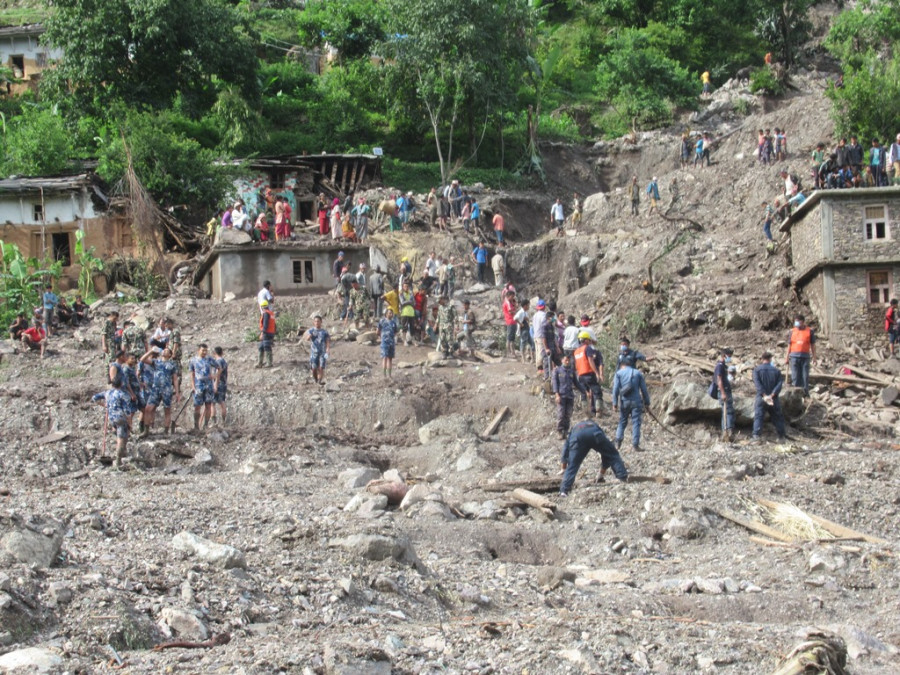National
With more rains predicted, there are fears of loss of more lives and properties across the country
Rising water levels in the rivers with widespread rainfall ring alarm bells as authorities warn this year’s monsoon could be among the deadliest in years.
Chandan Kumar Mandal
Every monsoon, Sher Bahadur Mahato is reminded of the incident that took place some two decades ago when the Narayani river changed its course and entered the riverside settlements displacing around 160 households.
Whenever it starts to rain, the 55-year-old farmer from Ratanpur in Madhyabindu Municipality in Nawalparasi (East) fears history repeating itself.
“The incident is still fresh in my mind,” said Mahato. “I remember the chaos, as if it was yesterday. Two decades down and we are still living with the same fear.”
In the first week of August 2000, when the farmers of Ratanpur, Nandapur, Sehari in Nawalparasi were busy in their paddy fields, water levels in the Narayani river suddenly started to rise and soon reached an alarming level. The same week floodwaters from the river submerged an entire village, and around 300 acres of cultivated land was lost.
“There was water everywhere,” said Mahato
The river has cut off large swathes of land in Ratanpur, Sehari and Nandapur areas over the years.
The erosion of the embankments of the Narayani river has increased the risk of floods in the settlements yet again. About a thousand families living in close proximity of the river are now at risk of being displaced.
While families of Madhyabindu are hoping for a long-term solution for tackling their annual trouble, the country’s monsoon concerns are not over yet.
With incessant rainfall since Sunday–and the prediction of its continuity for a few more days– the country is once again bracing for more devastation in the coming days.
The ongoing monsoon, which has already been touted as the deadliest in many years, is likely to wreak more havoc with the active monsoon unleashing more rainfall for the next few days.
The monsoon low-pressure system is shifting towards Nepal of late; precipitation has picked up pace since Sunday. Most parts of the country received light to moderate rainfall on Monday, ringing alarm bells for water-induced disasters.
The weather pattern is likely to continue for at least until Wednesday, as per the weather prediction bulletin for the next three days by the Meteorological Forecasting Division.
“Although light to moderate rainfall has been predicted across the country, the major impact is on Province 1, Province 2 and Bagmati Province,” Sajina Shakya, a meteorologist at the division, told the Post. “A few places in Sudurpaschim and Karnali will also witness heavy rainfall.”
According to Shakya, such high-intensity rainfalls cause dangerous flash floods.
“With continuous rainfall, chances of other water-induced disasters are also high,” said Shakya.
Following the adverse weather condition on precipitation, the authorities have already issued an alert about rising water levels in all the major rivers of the country.
A significant amount of water level surge was also predicted for Kankai, Koshi, Kamala, Bagmati, Narayani, Tinau, West Rapti, Babai rivers and their tributaries. Likewise, other rivers of Province 1, Province 2, Bagmati, Gandaki and Province 5 flowing through the Chure range and Tarai districts will also witness a similar rise in water levels, which could reach warning levels any time.
The Flood Forecasting Division under the Department of Hydrology and Meteorology (DHM) has asked communities living along these riverbanks to remain alert.
According to the weather office, the Lalbakaiya Basin of Bara has received 169.2mm of rainfall in the last 24 hours by Monday afternoon, followed by Syamgha station of Narayani (159mm), Danda station (150.2mm) and Gorkha station (143.2mm).
All these rivers had crossed their warning levels by Monday afternoon.
The water level in the Narayani river reached 9.51 metres at the Devghat station on Monday evening, crossing its danger level mark of around eight metres. The water level near the Narayani bridge station reached 12.31 metres, exceeding the warning level.
Mangalpur, Gunjnagar, Divyanagar and Meghauli in Chitwan have already been inundated by the Narayani river while the Nawalpur area is at a high risk of inundation.
The Chitwan District Administration Office on Monday morning issued a notice appealing to locals living in areas close to the Narayani river to remain alert as the water level in the river crossed danger level on Monday following heavy rainfall for the past 24 hours.
Keshav Bhattarai, 50, of Meghauli, Bharatpur Ward No. 27, said that the Nyurechok dam has so far saved his settlement, Dadrahani, from inundation, but the western embankment along the river next to his settlement is in immediate need of repair.
“Locals and security personnel were repairing the embankment before the water level started rising. The embankment hasn’t been completely repaired and the water level has crossed the danger level,” said Bhattarai. “The embankment will give in any day now if the water level continues to rise.”
Chitwan Chief District Officer Narayan Prasad Bhattarai said that his office has advised locals to remain vigilant for the next few days.
The Kankai river at Mainachuli station of Ilam also crossed its danger level on Monday evening. Also, water level of the Arun river at Simle and Tamor river at Mulghat station of Dhankuta went past its danger level.
The consequences of the incessant and intense rainfall have been reported from other parts of the country as well. At least two people were killed, and seven houses were buried in a landslide at Parigaun in Naugadh Rural Municipality Ward No. 6, Darchula on Sunday night.
In Sindhupalchok, the District Administration Office issued a notice warning locals of a potential outburst of Kerung Tso lake in Khasa region of China following heavy rainfall in Nyalam area.
Authorities have warned that the devastation could be bigger than the series of water-induced disasters experienced so far this season.
“The current rainy spell is likely to cause loss of lives and properties to a great extent, given that the landmass is already well saturated with rain in the last couple of weeks,” said Anil Pokhrel, chief executive officer of National Disaster Risk Reduction and Management Authority under the Home Ministry. “Rainwater will gush southwards to Tarai districts where vast swathes of land is already inundated.”
Out of the total 222 weather stations, which keeps rainfall data, 198 had recorded rainfall, with the highest rainfall of 169mm measured in Gharedhunga station of Kaski district, according to DHM. Likewise, three stations registered over 15omm of rainfall in the 24-hours period till Monday 8:45 am, followed by over 100mm in 23 stations, and over 50mm in 87 stations, among others.
According to Indira Kadel, chief of climate analysis section under the DHM, the country did not receive a record-breaking rainfall in the last couple of days but has witnessed heavy rains in many places.
“The current rainfall, starting from Sunday, has been more continuous covering a larger area than what we had witnessed last week and the weeks before,” Kadel told the Post. “The last time it was more isolated and concentrated in a few places where rainfall had crossed over 200mm. Now, it is more widespread across the country which is telling of the impacts of climate change in the country”
Since the arrival of the monsoon this year, landslides and floods alone have killed a total of 114 people and 48 have gone missing until Monday, according to the authority’s data. Besides, another 17 have been killed due to thunder and lightning strikes.
“The devastation caused in the first month of this monsoon season has already surpassed that of the previous years,” said Pokhrel. “This time we have also experienced a massive loss of infrastructure which is not a good sign.”
Authorities’ worry that more damage is to come from the fact that several areas have received massive rainfall in a short period of time. With the monsoon likely to stay till the last week of September, there is more devastation coming the country's way.
“We did not adequately consider disaster risk while planning settlements which should be necessary for a disaster-prone country like Nepal,” said Pokhrel. “The way we are constructing our roads in hilly areas is only increasing the risk of landslides. Poorly designed roads without disaster risk assessment only trigger more disasters.”
In Madhyabindu, locals are still suffering for a lack of a long-term sustainable solution to annual inundation the area faces every year.
Amar Bahadur Mahato, ward chairperson of Madhyabindu-3, said that although the local unit had allocated budget for the fiscal year 2020-2021 for construction of embankments along the Narayani river, repair and reconstruction work could not take off before the monsoons arrived.
“The local level alone cannot work towards preventing disasters every year,” he said. “We need to introduce a long-term solution which will need intervention from all levels of government.”
Nabin Paudel from Nawalparasi (East) and Ramesh Kumar Paudel from Chitwan contributed reporting.




 11.12°C Kathmandu
11.12°C Kathmandu















